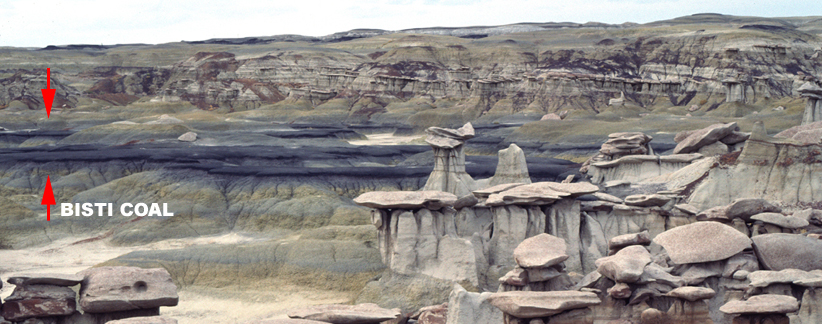
SEDIMENTARY ROCKS : MEDIUM FOR THE SAN JUAN BASIN
SCULPTURE GARDENS

SEDEMENTARY ROCKS: PARTICLE SIZES
Sedimentary rocks form when small particles are deposited and cemented together over millions of years under great pressure. Particle types and cementing materials that bind them are directly related to ancient depositional environments. Subsequent earth movements, heat, pressure, and ground water chemistry can further modify rocks over the millennia leaving additional clues about ancient environments.
Sedimentary rocks are first classified according to particle size. Sandstone the most commonly known of the series, consists of sand-sized particles. Conglomerate is formed from larger gravel sized particles cemented together by sandstone. Siltstone or Mudstone forms from relatively fine soil particles, while Shale comes from still smaller clay particles. Intermediate types like sandstone cemented with siltstone are also common in the badlands.
Limestone forms from compacted marine plankton shells and coral reefs. Shallow seas occupied the San Juan Basin several times during the Cretaceous period buy left no significant limestone deposits.
SEDIMENTARY ROCKS: DEPOSITIONAL PROCESSES
The next step in classifying sedimentary rocks relies on depositional processes and environments that provided the original sediments. There are 4 major categories as follows:
1) wind – sand dunes and prairie soils
2) fresh water-- rivers, streams, lakes, swamps, wetlands;
3) marine shoreline -- beaches, deltas, estuaries;
4) deep water marine -- offshore bays and seas.
All four rock types occur in the San Juan Basin, with type 1 being least common and type 2 the most, which already suggests a lot about the basin’s geologic history. The nine badlands featured here are carved mostly from type 2 with some 3 and 4.
SEDIMENTARY ROCKS: ORGANIC CONTENT
Organic material incorporated into the particle matrix is another important quality of sedimentary rocks. Plentiful coal, natural gas, and to a lesser extent oil, extracted from the San Juan Basin reflect a long, biologically rich past. Generally, the darker grey layer colors contained more organic materials during deposition and are now more carbonaceous or coal-like. Dark black coal bands are quite common in many badlands. Original efforts to get the Bisti declared wilderness in 1982 were in opposition to plans for strip mining rich coal deposits found throughout the badlands.

SEDIMENTARY ROCKS: FOSSILS
Fossils are the ultimate organic remains found in sedimentary rocks. Extremely abundant throughout the basin, they include everything from massive petrified wood forests to deepwater and shoreline marine creatures to dinosaurs, giant flightless birds, and early mammals. These amazing casts and replicas of ancient living things are the closest to actual time travel the paleoecologists can get. They make hundreds of millions of year old environments much easier to decipher.

| HOME |
GEOLOGY |
PHOTOGRAPHY TIPS | RECREATION | MAP - INDIVIDUAL BADLANDS |
| INDIVIDUAL BADLANDS PAGE | PHOTO TOURS |
BADLANDS OVERVIEW |
This site is property of PhotoTrekNM. All rights reserved. Copyright 2007.
